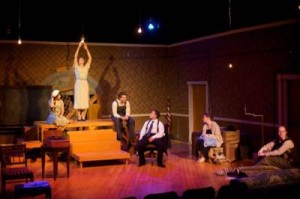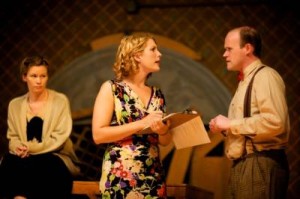
In the final five days of the homestretch of StageSceneLA’s 2nd calendar year, just when I think that there can’t possibly be another truly great new play (and production) to add to my upcoming Best Of 2008-9 lists, along comes Kit Steinkellner’s Adeline’s Play, the best World Premiere I’ve seen this year in a production which could not be better. Blessed with six performance gems and directed with love and finesse by Amanda Glaze, Adeline’s Play is the kind of play you find yourself enjoying so much that you simply can’t bear to see it end.

The year is 1934, America is in the darkest days of the Great Depression, and sad and dingy Flanagan, Illinois (population 2112) is a town without much hope. Things have gotten so bad that Flanagan has its own Hooverville, one of those shanty towns built by the homeless, who stand in line waiting for bread in a national economy gone horribly wrong.
Into this world with no bright future in sight comes a vision of promise—in the fortuitous return to Flanagan of its favorite daughter, the lovely Adeline Danner (Coco Kleppinger). Five years ago, on the very day she graduated high school, Adeline boarded a Greyhound bus bound for Los Angeles and never looked back. According to wide-eyed teenage Dot (Dina Percia), the first of our six narrators, Adeline Danner “went to Hollywood and she became a star. Everyone’s heard all about her big successes from the postcards she sends her family—she’s been an actress on the stage and screen and even a model in print! And of course, everyone’s seen her big starring moment in ‘It Happened One Night.’” Audience members will grasp at once that a seven-word bit part, even one in which she touched Clark Gable’s hand in the soon-to-be Oscar-winning Best Picture of 1934, does not a star make, and suspect that there must be more to Adeline’s return than a mere desire to direct and star in a local community theater production. For Dot and most of her fellow castmates, however, Adeline is a celebrity par excellence, and the best thing to happen to Flanagan since … well, since about forever!
Local would-be playwright Buddy Walters (Isaac Wade) sees Adeline’s return as a godsend. A “twitchy sort of person” who writes obituaries and small feature article for the local Gazette, Buddy claims to have a stack of plays, screenplays, short stories, and “parts of novels” stashed in the bottom drawer of his desk at the paper, covered under a lot of other papers. “I’m hoping to someday pull them out again,” he tells Dot, “and find that during their time in the dark they’ve become. Well. You know. Good.”
Only Dot and homeless Frank Sherman (Kyle Cadman) have shown up at the Town Hall Multi-Purpose Room to audition for The Lady In Blue on this hot, dusty evening smack dab in the middle of July. Frank, a young man who used to rent a room from Dot and her gran, now finds himself “one of the forgotten men that lives in tents and boxes down by the creek.” Like Dot, he hopes that appearing in Adeline’s play will bring back some of the brightness missing from his life over the year or so.
There are two other townsfolk in the Multi-Purpose room tonight, but auditioning for The Lady In Blue appears to be the last thing on either of their minds. Local curmudgeon C.B. Baldwin (Ariel Goldberg) is there to perform an early abortion of Adeline’s play, or at least postpone it till she’s got “forms, signatures, permission.” “I do not care whose hat you took or whose hand you may or may not have touched, you have to follow the rules like everybody else,” grumps C.B., a man who is (in Dot’s words), “a stick that got stuck so far in the mud you couldn’t even see the stick anymore.” Every bit as humorless as C.B. is Adeline’s drab, dreary, oh-so tightly-wound sister Elna (Sarah Watson), an overworked, underpaid factory assembly-liner who’s come to the Multi-Purpose room to talk with Adeline. “That’s the reason why I’m here,” she tells the assembled group. “The only reason, it’s that.”
If Elna is as gloomy as a dark and drizzly night, then Adeline is sunshine on a bright spring day, and before you know it, she’s managed to persuade both killjoys not only to audition, but to actually accept roles in the play. The upcoming weeks of rehearsals are to be held from 2:00 to 5:00 a.m. (the only time all six are available), and given no other viable alternative, the cast agree to the ungodly rehearsal hours, though not without objections. Clearly, the Road To Opening Night is going to be a bumpy one.
It also makes for an entirely captivating two acts. Spending time with Steinkellner’s six exquisitely drawn characters is something we can’t quite bear to see end, especially as each reveals him or herself to be quite the opposite of what we’d initially assumed. Even to hint at the changes each character will undergo would be to spoil Adeline’s Play’s many surprises. Suffice it to say, by the time lights cut to black, like Adeline herself, you too may find (in Adeline’s words) tears flooding up your throat and into your eyes and nose, tears of absolute joy and delight.
Director Glaze grew up hearing about the Great Depression from her grandmother, and her knowledge of and affection for the period shines through in her pitch-perfect direction. The cast she has assembled here is about as close to perfection as they come, beginning with the radiant Kleppinger in the title role. The actress is so unsinkably upbeat throughout most of the play that when she finally reveals what’s underneath the surface cheer, the result is all the more powerful and unexpected. Percia, fresh from New York, is a deliciously perky Dot, full of childlike joy in the way only a pre-cable TV, pre-Internet, pre-Twitter teen could be, a fifteen-year-old who reaches adulthood during Adeline’s play’s six weeks of rehearsals. Goldberg is absolutely wonderful as grouchy young C.B., a character so initially unendearing that by play’s end, you love him even more for having started out such a humorless party-pooper. Of all the marvelous cast, Goldberg best captures the sound and feel of the cinematic 1930s. The handsome, ingratiating Cadman brings a young Jimmy Stewart-Henry Fonda quality to the role of Frank, a man who refuses to let his down-on-his-luck status cloud his innate optimism.
With Adeline’s play, native Midwesterner Wade proves that his terrific work in 2007’s The Magic String was no fluke. In a part that seems to have been written with Wade’s name on it, the actor is all twitchy perfection. As this complex, adorable mess of doubt, confusion, and unrequited love, Wade gives a sublimely subtle and thoroughly winning performance.
Finally, there is the heavenly Watson in the role of Elna Danner. Frumpy and grumpy only begin to describe the embittered young woman we first meet, someone whose sole purpose in life seems to be putting a damper on anything and everything she touches. Precisely because Watson smartly refuses to make the initial Elna anything approaching lovable, the transformation which takes place in her over Adeline’s play’s six weeks of rehearsal is all the more stunning. Take a look at Watson when she first lets down Elna’s prudishly pulled-back hair in the second act and you will see a young Gena Rowlands at the start of her career.
Stellar as the cast’s performances are, the real star of Adeline’s Play is its writer. Steinkellner has written a Capraesque script worthy of comparison to the best of Kaufman and Hart. Her writing captures the language of the era with its “swells” and “crackerjacks” as well as its innocence and optimism in the face of joblessness and homelessness. Adeline’s Play is also a love letter to the theater, particularly to the tens of thousands of average everyday Americans who work dreary nine-to-fives and only come alive at night while rehearsing or performing their town’s latest community theater production. Adeline describes her play thus: “People aren’t going to know whether to roll in the aisles laughing or bawl into their handkerchiefs! All they’re going to know is that when the curtain goes down they’re going to have to stand up and cheer.” This is precisely how I felt as I watched Adeline’s Play, particularly its humdinger of a second act which had me laughing and crying in equal measure.
Scenic designer Nick Santiago has turned the built-in-1910 Powerhouse Theatre stage into precisely what we’d expect Flanagan’s tacky, cluttered Multi-Purpose Room to look like. Jenna Pletcher’s effective lighting design distinguishes between the action of the play (and the play-with-the-play), and the fourth-wall-breaking asides of its six narrators. Sound designer Corwin Evans has picked a great, era-establishing selection of 1930s tunes to link the show’s scenes, and Michelle Neumann’s costume choices seem straight out of a 30s Hollywood classic.
I feel I must apologize for this review coming so late in Adeline’s Play’s all-too-short 4–week run. Only a handful of performances remain before it closes on September 5th, and I can only hope that anyone reading this will get on the phone or go online posthaste and reserve seats to catch this wonder of a play and production before it’s too late.
Memo to regional theaters across the U.S.: Give Adeline’s Play a read—and the many future productions it deserves. If there is justice in the world of American theater, Adeline’s Play will live on (and delight audiences) long after its initial Santa Monica run is nothing but a cherished memory.
Los Angeles Theatre Ensemble, Powerhouse Theatre, 3116 2nd Street, Santa Monica.
www.latensemble.com
–Steven Stanley
August 27, 2009
Photos: Melissa Snyder of Vibble



 Since 2007, Steven Stanley's StageSceneLA.com has spotlighted the best in Southern California theater via reviews, interviews, and its annual StageSceneLA Scenies.
Since 2007, Steven Stanley's StageSceneLA.com has spotlighted the best in Southern California theater via reviews, interviews, and its annual StageSceneLA Scenies.







 COPYRIGHT 2024 STEVEN STANLEY :: DESIGN BY
COPYRIGHT 2024 STEVEN STANLEY :: DESIGN BY